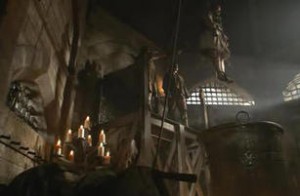
On this day in history, 5th April 1531, Richard Roose (Rouse) was boiled to death at Smithfield after being attainted of high treason.
Roose was the former cook of the household of John Fisher, Bishop of Rochester, and he’d been attainted after Parliament had passed a new bill, the “Acte for Poysoning”, which made it high treason to kill anyone with poison.
It was claimed that Roose had poisoned the pottage that had been served to the bishop and his guests on 18th February 1531. Two poor people, who’d been served leftovers as alms, died after eating it, and the bishop and his guests were taken ill but survived.
Also on this day in history, 5th April 1533, Convocation gave its ruling on Henry VIII’s marriage to Catherine of Aragon, stating that the Pope had no power to dispense in the case of a man marrying his brother’s widow, and that it was contrary to God’s law.